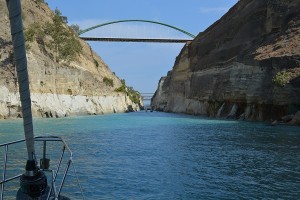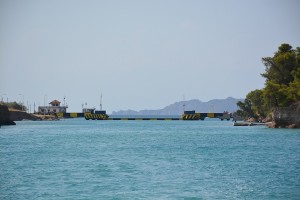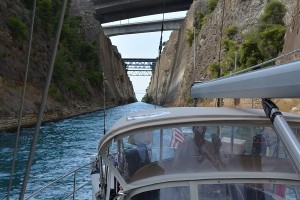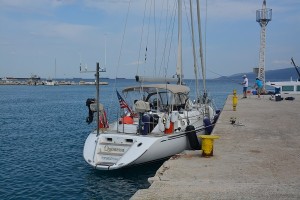Sunday, Aug. 9, 2015 —
Passing through the Corinth Canal had been on our bucket list from the first time we saw dramatic photos depicting this deep and extremely narrow land cut. One photo in particular showed a small cruise way below the rim of the canal with just a few feet of distance between the ship and the walls. The Canal cuts through the isthmus that connects the mainland of Greece to the Peloponnisos. Until it was finished in 1893, boats were dragged on rollers across the isthmus.
 Along with the thrill of motoring through the Canal, there is also the practical side to the route. The Canal provides the shortest distance from the Ionian Islands on the west coast of Greece to the Agean Sea with the Cyclades, Sporades, Saronic and Dodecanese Islands on the east. If you had to go around the Peloponnisos Peninsula it would add an additional 150 miles. Basically, the Canal is a 3.2 mile, 30 minute shortcut. Of course there is an additional two day trip from the Ionian Sea to the Canal itself, at least for boats of our size that only cruise at 6 to 8 knots. The route from the west passes through the Gulf of Patras and the Gulf of Corinth. We took additional time to stop at Galaxidhi and Delphi in the gulf.
Along with the thrill of motoring through the Canal, there is also the practical side to the route. The Canal provides the shortest distance from the Ionian Islands on the west coast of Greece to the Agean Sea with the Cyclades, Sporades, Saronic and Dodecanese Islands on the east. If you had to go around the Peloponnisos Peninsula it would add an additional 150 miles. Basically, the Canal is a 3.2 mile, 30 minute shortcut. Of course there is an additional two day trip from the Ionian Sea to the Canal itself, at least for boats of our size that only cruise at 6 to 8 knots. The route from the west passes through the Gulf of Patras and the Gulf of Corinth. We took additional time to stop at Galaxidhi and Delphi in the gulf.
As mentioned, the Canal is 3.2 miles long and only 80 feet wide. It is 259 feet high at its highest point. Open 24 hours/day, it is closed on Tuesdays to repair the natural limestone walls, which tend to crumble, and to dredge the bottom.  We actually expected to see walls that were more finished and smoother but the Canal is actually rough cut from the limestone and soil. At each end of the Canal there are hydraulic bridges that are lowered into the water for boats to pass over, rather than raised up for boats to pass under—a first for us. The Canal is so narrow that traffic only flows in one direction at a time. First the large ships go through, followed by smaller sail and power boats. Canal Zone authorities control the traffic flow, lining up boats by name and sequencing them. It is possible to have to wait up to three hours to pass through.
We actually expected to see walls that were more finished and smoother but the Canal is actually rough cut from the limestone and soil. At each end of the Canal there are hydraulic bridges that are lowered into the water for boats to pass over, rather than raised up for boats to pass under—a first for us. The Canal is so narrow that traffic only flows in one direction at a time. First the large ships go through, followed by smaller sail and power boats. Canal Zone authorities control the traffic flow, lining up boats by name and sequencing them. It is possible to have to wait up to three hours to pass through.
 We were fortunate. As we approached the Canal we announced ourselves from five miles out and requested permission to enter the Canal. The authorities told us to continue our present course and speed and radio them again at one mile out. We could see one tanker lined up and ready as well as two power yachts. We were the only sail yacht. Once we reached the staging zone we waited less than ten minutes before they lined us all up by name and told us to proceed. We saw the bridge at the entrance to the Canal lower into the water and disappear. One after another we all headed in.
We were fortunate. As we approached the Canal we announced ourselves from five miles out and requested permission to enter the Canal. The authorities told us to continue our present course and speed and radio them again at one mile out. We could see one tanker lined up and ready as well as two power yachts. We were the only sail yacht. Once we reached the staging zone we waited less than ten minutes before they lined us all up by name and told us to proceed. We saw the bridge at the entrance to the Canal lower into the water and disappear. One after another we all headed in.
 The passage took about thirty minutes – an expensive thrill. The Corinth Canal is one of the most expensive canals in the world, on a per mile basis. Yachts are charged by overall length. Our cost for the trip was 260 euros. Once we exited the eastern end of the Canal we tied up to a long dock and went in to the office to pay.
The passage took about thirty minutes – an expensive thrill. The Corinth Canal is one of the most expensive canals in the world, on a per mile basis. Yachts are charged by overall length. Our cost for the trip was 260 euros. Once we exited the eastern end of the Canal we tied up to a long dock and went in to the office to pay.
From there we moved around to the northern end of the bay, just off the east end of the Canal and spent the night at anchor. There were refineries around the northern corner and a lot of tankers but it was a nice quiet anchorage never the less. A perfect spot to hold up if you do not get through the canal until late in the day. We had a nice swim and dinner aboard.
